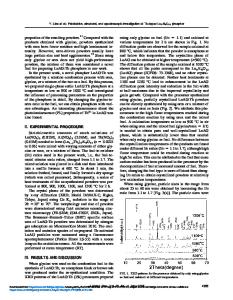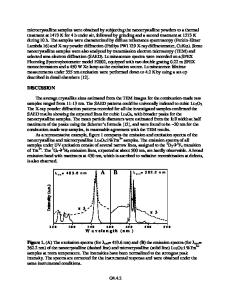Consolidation of translucent Ce 3+ -doped Lu 2 SiO 5 scintillation ceramics by pressureless sintering
- PDF / 792,236 Bytes
- 8 Pages / 584.957 x 782.986 pts Page_size
- 34 Downloads / 364 Views
The fabrication of Ce31-doped lutetium oxyorthosilicate (Lu2SiO5:Ce, LSO:Ce) scintillation ceramics was investigated by pressureless sintering starting from synthetic submicrometer polycrystalline LSO:Ce powder. It was found that translucent LSO ceramics were densified successfully with relative density of 99.5% under sintering condition of 1720 °C for 4 h. As-sintered LSO ceramics were pore-free with average grain size of 5 lm and exhibited a translucent state. The broad emission spectra centered at 419 nm of the LSO:Ce ceramics under vacuum ultraviolet (VUV) and UV excitation at room temperature. Under x-ray excitation, the overall emission intensity of obtained LSO ceramics achieved twice of that of bismuth germanium oxide (also known as bismuth germanate) single crystal at room temperature. Under excitation of 356 nm and emission of 420 nm, the luminescence decay time of the obtained LSO scintillation ceramics reached only 21.2 ns. The light yield of the LSO ceramics was 21,300 ph/MeV, which reached 91% of that of LSO single crystal.
I. INTRODUCTION 31
Ce -doped lutetium oxyorthosilicate (Lu2SiO5:Ce, LSO:Ce) has been proved to be a excellent scintillator for high-energy radiation detection owing to its good combination of chemical and physical properties, such as high effective atomic number (66), high density (7.4 g/cm3), high light output (;27,500 photons/MeV), and fast scintillation decay time (;40 ns). These merits also make LSO:Ce material as a promising candidate for bismuth germanate (BGO) scintillator which is most widely used in commercial positron emission tomography (PET) systems at present.1–4 Nevertheless, it is still difficulty to grow high-performance LSO:Ce crystal boules due to two main drawbacks. First, extremely high melting point (2100–2150 °C) of LSO phase is very close to the breakdown temperature of iridium crucible and heat insulation material made of stabilized zirconium dioxide (ZrO2) ceramics.5 Moreover, low segregation coefficient (;0.22) of Ce ions in LSO matrix results in increasing of the total cerium (Ce) concentration from top to bottom in the boule which brought about light yield fluctuation in obtained LSO:Ce crystal.6 In this decade, great efforts on fabrications of polycrystalline LSO:Ce powders,7–9 films,10,11 and ceramics12,13 with good scintillation properties have been carried out to provide a reliable alternative to the growth of LSO:Ce single crystal. Lempicki et al.12 first fabricated
the translucent LSO ceramics by hot pressing (HP) processing under a temperature of 1700 °C and pressure of 55 MPa. Wang et al.14 have achieved the LSO ceramics with higher optical transmittance (11% at 420 nm) by hot isostatic pressing (HIP) under the pressure of about 200 MPa. Scintillation properties (light output, decay time, and energy resolution) of the achieved LSO:Ce ceramics could be comparable to that of LSO:Ce single crystal.14 Xie et al.15 have also attained translucent LSO ceramics by spark plasma sintering (SPS) under the condition of 1350 °C and 50 MPa recently. These sinteri
Data Loading...











